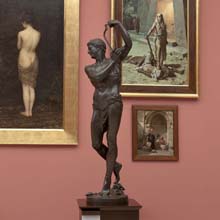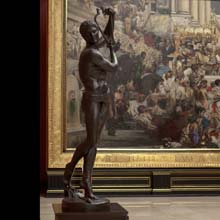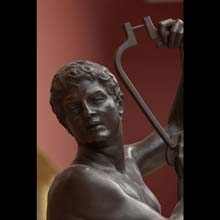


material: bronze
dimensions: 205 × 63 × 60 cm
description: Sclavus saltans is a full-size bronze sculpture of a life-size young slave, portrayed in a dancing pose, holding a lyre raised upwards. His legs are arranged in a dance-like manner, a mask is lying next to them. Following the academic fashion effectively, Weloński “dressed up” the subject of his sculpture in a classical costume, thus rendering the atmosphere of the epoch in a meaningful way. A slave should carry out the orders of his lord and master, obey him and, if necessary, provide entertainment. He is supposed to entertain, please his public, in this case also accompanying himself. It seems that the artist aimed at dramatic association of the lively pace of dancing with the compulsion under which the slave does it. What we can see here is a means of conveying emotions and the drama of feelings of all kinds. The sculptor employed the motif of dance to show the idealized human body of perfect proportions, modelled in accordance with academic patterns, in a dancing pose. The dancing slave appears as an allegory of the oppressed Polish nation, living at the bidding of the partitioners, one might say, “dancing to their tune.” Just as the existence of the Polish nation under the partitioners was a period of determination to keep up the national spirit and to fight with the oppressors – first in uprisings and, after their fall, to “struggle” in the field of education, in the era of positivism literature and art also abounded in references to Polish national pride. There were also a number of works reprimanding Poles for the gradual losing of the national unity and high self-esteem or even for subservient gestures to the oppressors. Anna Budzałek
exposition: The Gallery of 19th Century Polish Art in Sukiennice,
The Cloth Hall, 1, Main Market Square
key: Around the academy <<<
Paintings and sculptures on display in the room called “Around the Academy” were produced by artists influenced by the standards of art taught at the academies of fine arts and shown at official exhibitions, that is academic art which usually appealed to the tastes and interests of the elites and the more affluent part of the society.
In the 19th century, European painting was under the influence of academies which implanted in students the universally accepted standards of artistic creation, established already in the 17th century by the Royal Academy of Painting and Sculpture in Paris. According to these principles, art gives real shape to ideal beauty and expresses noble subjects taken from the Holy Scripture, mythology, literature and history, to be depicted as a tale, or history. As a result, in the academic hierarchy of genres, history painting was regarded as the highest form of painting, because while painting a story, an artist had an opportunity to show off his erudition based on the literary text. Slightly lower in the hierarchy were landscape painting, portraiture and genre painting, and still life was placed at the bottom. Some artists defied those principles, which led to the emergence of new trends towards the end of the century – Realism and Impressionism.
In general, the term “academism” in the 19th-century art refers to paintings and sculptures characterised by the sublime content and precision of the finish, known as fini. In the second half of the 19th century, when the artistic value of the sketch began to be appreciated and the representation of idealized subjects was gradually supplanted by realism, not all academicians followed the above standards. Constant changes which the term ‘academician’ and the principles of academic painting were subject to in the 19th century were the reason to call this part of the exhibition “Around the Academy.”
Painting illustrating historical themes changed considerably in the 19th century. Along with the development of archaeological and historical research, the knowledge of the realities the old days increased. The public demanded more and more of the erudite artist: not only did he have to familiarize himself with a literary text and depict it in the painting, but he was also expected to verify written and pictorial historical sources to illustrate past events accurately and objectively. While in the first half of the 19th century literary subjects were still dominant in Polish history painting, in the latter half of the century it was more common to illustrate themes taken from historical sources (e.g. Prussian Homage by Jan Matejko, Battle of Cecora by Witold Piwnicki). It was Jan Matejko who took a special place in Polish history painting, often being considered as the founder of this movement. What is extraordinary about his fame is that his works, satisfying the Poles’ desire to see the full glory of the nation’s past, were, and still are, admired by the whole nation.
Ancient times, most beautifully illustrated in the canvases of Henryk Siemiradzki and sculptures of Pius Weloński, served as an important subject. In the 19th century, it was believed that the fate of the persecuted Christians and Slavic gladiators bore some resemblance to the situation of the oppressed Poles, suggesting that the nation, like the ancient heroes, also had a chance to free themselves from the yoke of bondage.
The work by Feliks Cichocki-Nałęcz Mother of God as a Spinner, which combines a “modernized” image of Mother of God, shown during everyday work, with a traditional, in terms of technique and composition, way of painting, typical of the academic art of the second half of the 19th century, is an example of a novelty in academic religious painting.
Visits of Europeans to Africa and Asia aroused Polish artists’ interest in oriental motifs. Their works depicted uncomplicated genre scenes, clothes and objects typical of the general impressions of a tourist going to exotic countries (e.g. By the Well by Tadeusz Ajdukiewicz). The Polish public was more likely to accept and appreciate genre scenes if they contained some patriotic allusions and referred to national tradition or history (The Zwierzyniec Hobby Horse by Hipolit Lipiński).
Despite the discovery of photography, painted portraits retained their popularity and were still watched and valued not only by critics and exhibition audiences, but also people who ordered such works. This painting genre is shown on the example of official portraits painted by Jan Matejko, Henryk Rodakowski, Kazimierz Pochwalski and Pius Weloński.
Barbara Ciciora
dimensions: 205 × 63 × 60 cm
description: Sclavus saltans is a full-size bronze sculpture of a life-size young slave, portrayed in a dancing pose, holding a lyre raised upwards. His legs are arranged in a dance-like manner, a mask is lying next to them. Following the academic fashion effectively, Weloński “dressed up” the subject of his sculpture in a classical costume, thus rendering the atmosphere of the epoch in a meaningful way. A slave should carry out the orders of his lord and master, obey him and, if necessary, provide entertainment. He is supposed to entertain, please his public, in this case also accompanying himself. It seems that the artist aimed at dramatic association of the lively pace of dancing with the compulsion under which the slave does it. What we can see here is a means of conveying emotions and the drama of feelings of all kinds. The sculptor employed the motif of dance to show the idealized human body of perfect proportions, modelled in accordance with academic patterns, in a dancing pose. The dancing slave appears as an allegory of the oppressed Polish nation, living at the bidding of the partitioners, one might say, “dancing to their tune.” Just as the existence of the Polish nation under the partitioners was a period of determination to keep up the national spirit and to fight with the oppressors – first in uprisings and, after their fall, to “struggle” in the field of education, in the era of positivism literature and art also abounded in references to Polish national pride. There were also a number of works reprimanding Poles for the gradual losing of the national unity and high self-esteem or even for subservient gestures to the oppressors. Anna Budzałek
exposition: The Gallery of 19th Century Polish Art in Sukiennice,
The Cloth Hall, 1, Main Market Square
key: Around the academy <<<
Paintings and sculptures on display in the room called “Around the Academy” were produced by artists influenced by the standards of art taught at the academies of fine arts and shown at official exhibitions, that is academic art which usually appealed to the tastes and interests of the elites and the more affluent part of the society.
In the 19th century, European painting was under the influence of academies which implanted in students the universally accepted standards of artistic creation, established already in the 17th century by the Royal Academy of Painting and Sculpture in Paris. According to these principles, art gives real shape to ideal beauty and expresses noble subjects taken from the Holy Scripture, mythology, literature and history, to be depicted as a tale, or history. As a result, in the academic hierarchy of genres, history painting was regarded as the highest form of painting, because while painting a story, an artist had an opportunity to show off his erudition based on the literary text. Slightly lower in the hierarchy were landscape painting, portraiture and genre painting, and still life was placed at the bottom. Some artists defied those principles, which led to the emergence of new trends towards the end of the century – Realism and Impressionism.
In general, the term “academism” in the 19th-century art refers to paintings and sculptures characterised by the sublime content and precision of the finish, known as fini. In the second half of the 19th century, when the artistic value of the sketch began to be appreciated and the representation of idealized subjects was gradually supplanted by realism, not all academicians followed the above standards. Constant changes which the term ‘academician’ and the principles of academic painting were subject to in the 19th century were the reason to call this part of the exhibition “Around the Academy.”
Painting illustrating historical themes changed considerably in the 19th century. Along with the development of archaeological and historical research, the knowledge of the realities the old days increased. The public demanded more and more of the erudite artist: not only did he have to familiarize himself with a literary text and depict it in the painting, but he was also expected to verify written and pictorial historical sources to illustrate past events accurately and objectively. While in the first half of the 19th century literary subjects were still dominant in Polish history painting, in the latter half of the century it was more common to illustrate themes taken from historical sources (e.g. Prussian Homage by Jan Matejko, Battle of Cecora by Witold Piwnicki). It was Jan Matejko who took a special place in Polish history painting, often being considered as the founder of this movement. What is extraordinary about his fame is that his works, satisfying the Poles’ desire to see the full glory of the nation’s past, were, and still are, admired by the whole nation.
Ancient times, most beautifully illustrated in the canvases of Henryk Siemiradzki and sculptures of Pius Weloński, served as an important subject. In the 19th century, it was believed that the fate of the persecuted Christians and Slavic gladiators bore some resemblance to the situation of the oppressed Poles, suggesting that the nation, like the ancient heroes, also had a chance to free themselves from the yoke of bondage.
The work by Feliks Cichocki-Nałęcz Mother of God as a Spinner, which combines a “modernized” image of Mother of God, shown during everyday work, with a traditional, in terms of technique and composition, way of painting, typical of the academic art of the second half of the 19th century, is an example of a novelty in academic religious painting.
Visits of Europeans to Africa and Asia aroused Polish artists’ interest in oriental motifs. Their works depicted uncomplicated genre scenes, clothes and objects typical of the general impressions of a tourist going to exotic countries (e.g. By the Well by Tadeusz Ajdukiewicz). The Polish public was more likely to accept and appreciate genre scenes if they contained some patriotic allusions and referred to national tradition or history (The Zwierzyniec Hobby Horse by Hipolit Lipiński).
Despite the discovery of photography, painted portraits retained their popularity and were still watched and valued not only by critics and exhibition audiences, but also people who ordered such works. This painting genre is shown on the example of official portraits painted by Jan Matejko, Henryk Rodakowski, Kazimierz Pochwalski and Pius Weloński.
Barbara Ciciora












